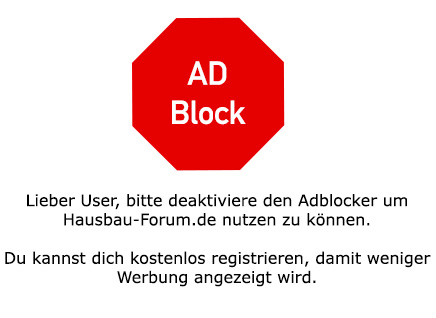Häuslebau3r
2015-09-10 07:34:28
- #1
Good morning,
regarding the other providers, it is certainly not wrong to get more opinions and incentives. Often this reinforces a decision or makes one question clearer. Of course, the value of comparisons also increases immensely.
Regarding the plot of land, if there is still room for maneuver (which is absolutely unthinkable in our area), as you wrote, that will certainly take some time.
The question of starting the construction project in April 2016 can really only be answered by the construction companies. If you are clear about what exactly you want and the companies agree to it, why not. In my case, I am also just at the beginning (just acquired the plot), but the start of construction is still pending, although it is probably the case with us that planning for construction should (or must) start about one year in advance.
As mentioned, it is often a question of technology and materials used. If it is clear to you from the outset that you do not want an oil heating system or possibly not even a gas heating system, you will automatically come closer to the values of Kfw55 / KFW70 and almost answer this yourself (do not forget that of course other factors come into play, such as masonry, windows, etc.). Naturally, some variants are more expensive to purchase than others. Just compare gas condensing boilers, air-water heat pumps with ground-source heat pumps. An additional effort or higher cost compared to a non-KFW70 house is surely self-explanatory, but in my opinion, only a professional can make an efficiency calculation for about 30 years tailored to your personal house (in the region). For me, for example, oil or gas would not be an option (for future-oriented reasons alone).
Here, of course, I can also refer to the middle post written above. As an allergy sufferer, a ventilation system would be an option for me from April to September anyway, as I hope for an improvement mainly in the cozy home. There are also filters for ventilation systems for this purpose. Although I have heard and read both positive and negative things so far regarding bacteria (stagnant air), etc. The aspect you wrote about concerning drying time would also be a plus for me.
The system you mentioned (the combination) of photovoltaic + air-water heat pump + ventilation system + underfloor heating is not only available from Viebrockhaus but also from all other providers. In these systems, the best possible combination must simply be assembled for the builder. In some regions, a ground-source heat pump is used because the average temperature over the year is too cold, in others, because the plot is large enough, surface collectors are used, and so on. Ultimately, the right solution for your house, for your region and for you will be filtered out, or it should be so.
regarding the other providers, it is certainly not wrong to get more opinions and incentives. Often this reinforces a decision or makes one question clearer. Of course, the value of comparisons also increases immensely.
Regarding the plot of land, if there is still room for maneuver (which is absolutely unthinkable in our area), as you wrote, that will certainly take some time.
The question of starting the construction project in April 2016 can really only be answered by the construction companies. If you are clear about what exactly you want and the companies agree to it, why not. In my case, I am also just at the beginning (just acquired the plot), but the start of construction is still pending, although it is probably the case with us that planning for construction should (or must) start about one year in advance.
As mentioned, it is often a question of technology and materials used. If it is clear to you from the outset that you do not want an oil heating system or possibly not even a gas heating system, you will automatically come closer to the values of Kfw55 / KFW70 and almost answer this yourself (do not forget that of course other factors come into play, such as masonry, windows, etc.). Naturally, some variants are more expensive to purchase than others. Just compare gas condensing boilers, air-water heat pumps with ground-source heat pumps. An additional effort or higher cost compared to a non-KFW70 house is surely self-explanatory, but in my opinion, only a professional can make an efficiency calculation for about 30 years tailored to your personal house (in the region). For me, for example, oil or gas would not be an option (for future-oriented reasons alone).
Here, of course, I can also refer to the middle post written above. As an allergy sufferer, a ventilation system would be an option for me from April to September anyway, as I hope for an improvement mainly in the cozy home. There are also filters for ventilation systems for this purpose. Although I have heard and read both positive and negative things so far regarding bacteria (stagnant air), etc. The aspect you wrote about concerning drying time would also be a plus for me.
The system you mentioned (the combination) of photovoltaic + air-water heat pump + ventilation system + underfloor heating is not only available from Viebrockhaus but also from all other providers. In these systems, the best possible combination must simply be assembled for the builder. In some regions, a ground-source heat pump is used because the average temperature over the year is too cold, in others, because the plot is large enough, surface collectors are used, and so on. Ultimately, the right solution for your house, for your region and for you will be filtered out, or it should be so.
